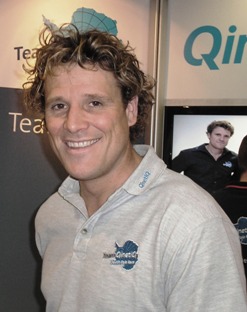 Sarah Day attends two events aimed at persuading young people that science is for them, and comes to the conclusion that it works best when the science is allowed to speak for itself…
Sarah Day attends two events aimed at persuading young people that science is for them, and comes to the conclusion that it works best when the science is allowed to speak for itself…
Geoscientist Online 13 March 2009
Next to the government, the NHS and immigrant workers, a popular Daily Mail-reader rant is the ‘youth of today’. They have no respect. They have it too easy at school. They wear sinister jumpers with hoods attached. And they certainly have no interest in worthwhile things like science and engineering.
March 6-15 2009 has been National Science and Engineering Week, and has featured lots of events that hope to combat this apparent apathy. The biggest of these was the UK Young Scientists & Engineers Fair, ‘The Big Bang’, ranging over three days and five floors of the Queen Elizabeth II Conference Centre in Westminster. Any Daily Mail readers attending the Big Bang would find themselves well and truly stumped. I’m happy to report that, judging by the young people we met over the three days (4-6 March), science and engineering is alive and well in schools. Admittedly, they were probably a very select sample and not particularly representative of the average, but it’s still nice to know that there are enough bright, enthusiastic and disturbingly well behaved 11-19 year olds to fill the QEII Centre for three days.
The aim of the fair is to inspire students to study for a future in science and engineering, and to raise their awareness of the huge range of careers such study could lead to. As well as exhibitions and theatre shows, a main feature of the event was the competitions, including the National Science Competition to find the first UK Young Scientist and Young Technologist of the Year.
For the Geological Society, the event represented an opportunity to raise awareness of the subject, which is often taught in a fragmented way in schools. Armed with a ‘Seismic Simulator’ (think very slow driving game, but with a boat), cute button badges and pictures of geologists at work in exotic locations, we were encouraged by the level of interest and enthusiasm shown by visitors to the stand, many of whom had been studying geology at school and thinking it was geography.
Nearest to us was a stand about physiology and healthy living. I have to admit, I didn’t notice exactly which organisation this was run by, so distracted was I by the presence of James Cracknell, Olympic rower and love of my life, who’s just come back from an expedition to the Antarctic, as you do. I managed to pull myself together for long enough to ask about the trip, and whether he came across any evidence of geologists at work in the region.
‘There were quite a lot of American scientists there, but they were doing more molecular science’ he tells me. Then he thinks for a bit. ‘There were some Norwegian scientists who seemed to be moving lots of boulders around, and doing stuff with rocks’. "Ah ha! They were probably geologists", I tell him.
Unfortunately for my article, it turns out James was in the Antarctic mainly to take part in a race – a 495-mile trek across the Antarctic ice cap against five other teams, recreating Captain Scott’s race to the South Pole back in 1912. Nevertheless, the trip did give him a unique insight into the environmental issues the world is facing.
‘It’s an amazing, beautiful place that needs to be looked after’, he agreed, although he admitted that it was hard for him to observe the effects of climate change first hand. ‘All we could see was mountains and ice, and when you go above the mountains you can’t see anything’. Such unspoiled landscape is potentially under threat, however, with the Protocol on Environmental Protection to the Antarctic Treaty due for a review in 2041. The treaty, signed in 1991, prohibits any mining activity in the Antarctic, which is sitting on valuable oil and natural gas fields. If not renewed, the excavation of the area could destroy the landscape forever.
‘Either way’, James pointed out, ‘we have to find a way of surviving that doesn’t involve using those resources. We can’t carry on like we are, using oil at the rate we are. Hopefully in 30 years time we’ll have come up with an alternative. I think we underuse nuclear power, for example’.
It’s possible after this that he outlined a comprehensive and insightful solution to the energy crisis, but I’m afraid I was distracted by his penetrating eyes and lovely floppy hair, so I missed it.